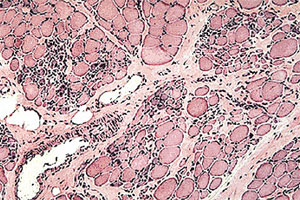Hereditary diseases caused by a genetic anomaly are caused by changes in the genes, caused by mutations. Genetic diseases are usually classified into autosomal dominant heritage, autosomal recessive heritage and linked to sex. There are also multi-factorial disorders, which are characterized by the interaction of genetic and environmental factors. These last ones are classified into congenital malformations or as diseases with a genetic predisposition (example, cleft lip).
Autosomal dominant heritage
Pathologies caused by this type of heritage are caused by the existence of an abnormal gene in one of the autosomal chromosomes (one of the first 22 chromosomes, meaning, not the sexual cells) of any of the two parents. Only one of the parents has to have an abnormal gene in order for the child to inherit the disease. Some of the afflictions resulting from this type of heritage are:
-Huntington’s disease: is a genetic disorder in the fourth chromosome that is passed on from parent to child and consists on the neurons slowly being destroyed or worn out within the brain. The main symptoms are abnormal movement, like facial ones (making faces), slow motion, hallucinations, irritability, and memory loss, among others. There are two forms of this disease, the most common one is during adulthood, and the other, which is less frequent, begins at an early age (childhood or adolescence). In the second one, the symptoms can look like Parkinson’s disease, like stiffness, slow movements and shaking.
– Familial hypercholesterolemia (FH): it is a hereditary genetic affliction that causes several mutations in the receptor gene of LDL cholesterol (low density lipoprotein).High levels of this cholesterol generally happen from birth and end up causing serious cardiovascular problems (infarctions and chest anginas) before the age of 55.
Autosomal recessive heritage
Diseases caused by this type of heritage are due to an abnormal gene in one of the autosomal chromosomes of each parent. In order for this disorder to develop, both parents must be carriers, and when the child inherits the gene from one of the parents, they become a carrier. Some of the pathologies of this type of heritage are:
–Phenylketonuria (PKN): it is a rare congenital child disorder in which the body does not properly metabolize the amino acid called phenylalanine due to lack of the liver enzyme called phenylalanine hydroxylase. This absence causes damage in the central nervous system, causing mental retardation towards the end of the first year of life. Also, phenylalanine plays an important role in the production of melanin (hormone responsible for skin color). Little ones that present this affliction usually have lighter skin.
– Cystic fibrosis (CF): it is a hereditary disease that causes the accumulation of thick mucus in the lungs and pancreas, causing serious pulmonary infections and serious digestive problems. The cause is a defect in the seventh chromosome. This disorder can also affect the sweat glands and male reproductive organ. The main symptoms are absence of depositions the first two days of life, frequent respiratory infections (like pneumonia), weight loss or absence of weight gain, late growth, among others.
– Hemochromatosis: it is an affliction characterized by the excessive deposit of iron in the body (specifically, in the liver), causing the widening of this organ. The disease can lead to the development of other pathologies like diabetes, cardiac problems, arthritis, cirrhosis of the liver, liver cancer, etc. There are two kind of hemochromatosis: primary and secondary or acquired. The first is caused by a problem in the genes or by receiving many blood transfusions and the second can be caused by diseases like sideroblastic anemia.
– Leukodystrophia: it is a pathology that progressively gets worse in time and affects the nerves, muscles and other organs of the body. It is generally caused by the lack of the enzyme arylsulphatase A.Due to the lack of this enzyme, some chemicals dubbed sulphatides accumulate in several parts of the body, causing damage wherever this deposit is present. There are three kinds of leukodystrophia and they are based on the beginnings of the symptoms: late childhood, juvenile and adult or late juvenile. In the first one, the symptoms begin at age four and go from problem walking to diminished mental functions; in the second one, the symptoms begin between the ages of four and six and cause problems getting around, and the third manifests between the ages of six and 16, in the adult case, over 16. The symptoms of this last case can be behavioral problems, loss of mental faculties and muscle control, and convulsions.
– Tay-Sachs disease: it is a deadly hereditary disorder of the 15th chromosome that causes damage to the central nervous system. It is caused when the body lacks hexosaminidase A, a protein that helps breakdown a chemical found in the nerve tissue known as ganglioside. Without this protein, the chemical accumulates in the cells, specifically in the neurons. Its main symptoms are deafness, blindness, convulsions, slow growth, irritability, among others.
Diseases linked to sex
They are the disorders that are inherited through the X or Y sexual chromosomes. Dominant heritage takes place when an abnormal genes of one of the parents is capable of causing an affliction, and recessive heritage takes place when both of the parent’s genes are abnormal. This way, the child will develop a disease.
– Hemophilia: it is a genetic pathology that consists on the inability of blood to coagulate. It is characterized by the appearance of internal and external hemorrhages due to a lack of the coagulation protein called antihemophelic globulin (coagulation factor). There are two kinds of this disease:
1. Hemophilia A: it is caused by a recessive hereditary trait linked to the X chromosome (lack of the coagulation factor VIII). This means it generally presents itself in women since they have two copies of chromosome X. This way, if the factor VIII gene doesn’t work, the other chromosomes’s gene can compensate. However, men only have one X chromosome, therefore, if this chromosome’s factor VIII gene is damaged, the child will develop hemophilia A. The main symptoms are bruises, prolonged bleeding caused by wounds, dental extractions or surgery.
2. Hemophilia B: it is caused by the deficiency of a protein called factor IX of coagulation. It is less common than A and the most important risk factor is being a man. The main symptoms are almost the same as hemophilia A.
– Duchenne’s muscular dystrophy: it is a disease characterized by progressive muscular weakness that begins in the legs and pelvis and then spreads to the entire body. A defective gene of the protein called dystrophin causes it. Generally, the symptoms appear before the age of six and lead to respiratory disorders and heart problems.
Other pathologies
Cleft lip and cleft palate: it is a congenital defect that affects the upper lip and palate. It is produced during the first three months of pregnancy because it is then that the upper parts of the palate and lip join. When this union does not take place, the baby presents this defect when it is born. It especially happens to families that have already had someone with this problem.
–Patau syndrome: also known has trisonomy of chromosome 13, it is a rare chromosomic disorder that is characterized by the presence of an extra chromosome 13. A baby that is born with this syndrome has multiple anomalies (brain defects that lead to convulsions or apnea, deafness and ocular problems), many of which are incompatible to life. In fact, over 80% of these babies die within the first month.








